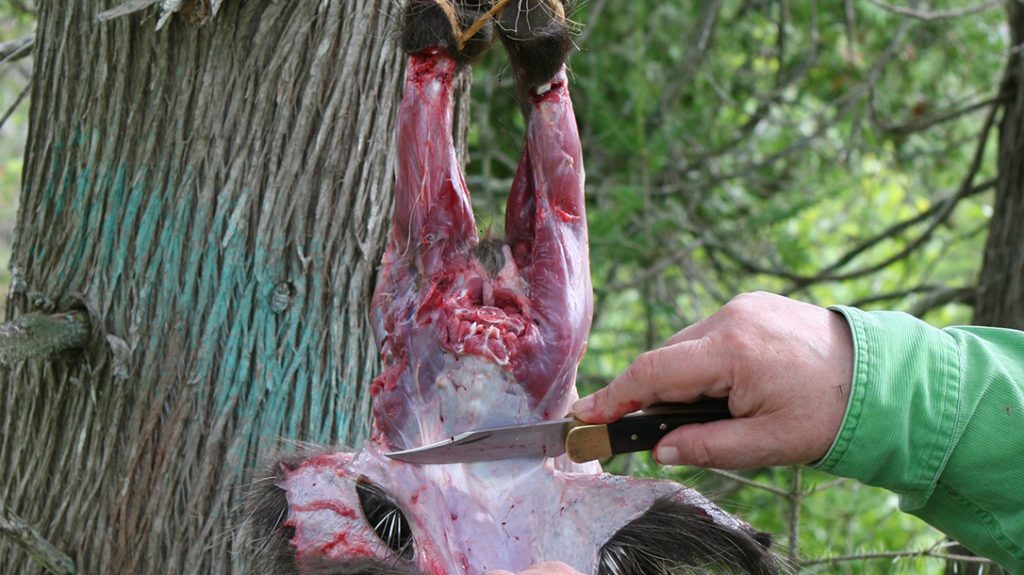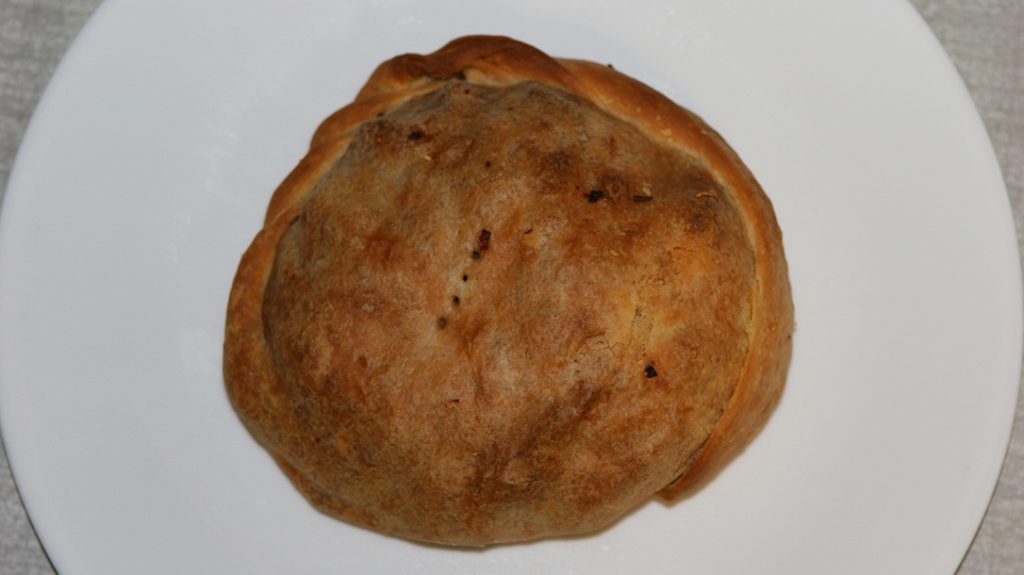Since I was a boy, I’ve always heard that porcupines are excellent survival food because they are easy to catch and club if you don’t have any weapons. But no one ever addressed how to handle the critters for eating. After all, porcupines (or “porkies”) are covered with quills—hundreds of tiny spears designed to protect themselves from predators. Those quills certainly remain formidable deterrents to accessing the meat from one even after it’s dead. How much good can porcupine meat be as a survival food if you end up getting your hands bloodied from quills while trying to make use of it? Cooking porcupine is an art.
Cooking Porcupine as Survival Food
The mystery surrounding how to handle a porcupine for consumption remained until I hunted black bear with a Native American guide in Saskatchewan who grew up eating them. His name is Brian MacDonald, and he lives in Buffalo Narrows. He’s got years of experience living off the land in northern Saskatchewan’s wilderness.
“You burn everything off, the quills and hair, over an open fire before you cook it,” MacDonald said. “That’s the simplest way to get rid of the quills before handling the carcass to prepare it to cook, so you can avoid getting stabbed.
“Scorching the quills and hair this way gives the meat a special flavor. I remember the last one I ate with my cousin, and we really enjoyed it. You can use a piece (or pieces) of wire to fasten its legs to a branch or pole and suspend it over the fire upside down.
“If you’ve got a fire that’s burned down to the coals, you can lay a porky on the coals, quills down, and roll it from side to side to burn off the quills, too. But you don’t want to do this too long. If there are any quills remaining after you take the porky off the coals or out of the fire, scrape them off.
“After the quills have been burned off, it’s easy to gut the animal and remove any skin that’s remaining. Then we cut the carcass up into pieces and boil it. The meat from porcupines is real rich and delicious.”
Skinning Secrets
Since talking to Brian about his method of removing quills from porkies, I found out that there’s an alternative. Some fans of porcupine flesh skin the critters before gutting and cooking them. How do you skin a porky? Very carefully!

Seriously, it’s not really as bad you might think. Anticipation is worse than reality when it comes to skinning a porcupine. Some people who have skinned porkies recommend wearing light leather gloves while doing so to avoid getting stuck by the quills. In preparation for writing this article, I skinned a porcupine myself—and I did it barehanded. Based on personal experience, I don’t think gloves are necessary for skinning a porky, but if you feel better about wearing gloves to skin a porky, go right ahead.
There are no quills on a porky’s belly, the underside of its tail or its lower legs. All of the quills are on top of the tail and the animal’s back and sides. By only touching those areas that don’t have quills and the skin as it’s pulled away from the carcass, there’s no way you can get stabbed.
It’s best to hang a porky by its hind legs for skinning. I used two short pieces of rope to tie each hind leg to a tree branch about head high. Step one is to make a cut around each hind leg below the rope. Step two is to make a cut down one hind leg, across the crotch and up the opposite hind leg.
Further Cuts
Once those two cuts are made, simply separate the skin from each hind leg with your knife blade. Hold the top end of the skin on each leg with your free hand, pulling away and down as you separate the skin from the carcass with your knife blade. Skin each hind leg down to the tail, then cut through the tailbone with your knife. You can push down on the underside of the tail to help break the tailbone. It will be easier to cut through the tailbone if you can find a joint in the bone.
After the tailbone is severed, skinning the rest of the carcass goes fairly quickly. The weight of the tail and its many quills helps pull the hide down as you slice between the skin and carcass with your knife. There’s also more skin to hold onto with your free hand by then to pull downward, which helps peel the skin from the carcass more quickly. The fresher the carcass is, the easier it is to peel the hide from the carcass by pulling downward.
I skinned the porcupine I worked on down to the neck, and then cut the head off at the neck. If you want to save the entire hide and quills, the head can be skinned as well. Some people use porky quills for artwork or crafting. I think a preserved porcupine hide would make a neat decoration.
Critter Cookin’
Once a porky has been skinned, the animal can then be gutted and butchered without worry about the quills. Although a porcupine carcass can be cut into pieces for cooking, like Brian MacDonald typically does, the animal can also be cooked in one piece after it has been thoroughly cleaned and rinsed with water. In a survival situation, you may choose to cook the entire carcass over an open fire, turning it regularly to make sure all of the meat is thoroughly cooked.
One person who dines on porcupines regularly recommends chilling the meat to remove all of the fat. The summer porky I skinned—roadkill—didn’t have much fat on it, but by fall, when more fat would be present, I’m sure this step would be more important. They also recommend parboiling the carcass while covered with simmering water to which a teaspoon of baking soda has been added. The timing for parboiling is 15 minutes. After parboiling, the carcass can then be baked.
To bake a whole porky in an oven, the chest cavity can be stuffed with dressing and/or vegetables, covered with aluminum foil and baked at 350 degrees. In terms of cooking time, allow 20 minutes per pound plus 30 minutes. Always check to make sure all of the meat is thoroughly cooked before serving.
Put water or broth in the baking pan to keep things moist. Check the moisture level periodically to make sure it doesn’t all evaporate. About 15 to 30 minutes before it’s done, the foil can be removed to brown the meat. Some people also apply butter or margarine to the meat at this point.
Other Methods of Cooking Porcupine
Porcupines can also be baked, either whole or in pieces, in barbecue sauce, gravy or soups to keep the meat moist. When using gravy or soups, vegetables can be added to go with the meat.
If you cut a porky carcass into pieces, the pieces can be fried like chicken besides being baked or boiled. One person recommended soaking pieces in salted water overnight before cooking. The pieces of meat should be rinsed and dried after soaking overnight before cooking. Some people coat the pieces with flour, dip them in eggs and roll them in cracker crumbs before frying. Porky pieces can also be coated with Shake & Bake for baking in the oven.
Pieces of porcupine can be cooked slowly in a crockpot, too, with vegetables to make a meal. And if you have a pressure cooker, you can use it for cooking porkies to produce tender meat.
Versatile Ingredient
There’s no end to how porcupine meat can be used. It can be substituted into any meat dish. For instance, a regional favorite in Michigan’s Upper Peninsula, where I live, is a type of meat pie called a “pastie.” Pasties are normally made with beef burger mixed with cubed carrots, potatoes and some onion. Porky meat can be substituted for the burger.

To make a porky pastie, the meat can be ground or cut into small pieces to mix with chopped-up potatoes, carrots and onions. Put a softball-sized portion of the meat and veggies on a pie crust. Fold the crust over the contents and pinch the edges closed. Bake the completed pasties on a cookie sheet at 325 to 350 degrees for 45 minutes to an hour. I like to pour ketchup on my pasties when eating them. Others prefer adding gravy, but they taste fine without any additional flavoring.
Cooking Porcupine Stews
Chunks of porky meat can also be used in stews or stroganoff. My wife and I make two types of stroganoff with venison or bear meat that porky meat can be substituted for. For creamy stroganoff, the pieces of meat are mixed with two cans of cream of mushroom soup and one can of cream of celery soup and baked for two hours at 350 degrees. Sour cream is mixed in before serving over wide egg noodles.
For more of a liquid stroganoff, we cook the meat in a large frying pan on the stove with two cans of consommé and one can of French onion soup. A small can of mushrooms is another ingredient. When the meat is almost ready to serve, sour cream is stirred in. The meat and broth are added to minute rice in a bowl and eaten with a spoon. Porcupine burgers are another option for ground porky meat. Patties can be cooked in a frying pan as they are or mixed with onion soup mix and crackers.






![Air gun 101: The differences between .177 & .22 – Which jobs they do best ? [Infographic]](https://airgunmaniac.com/wp-content/uploads/2020/09/g44-218x150.jpg)



































